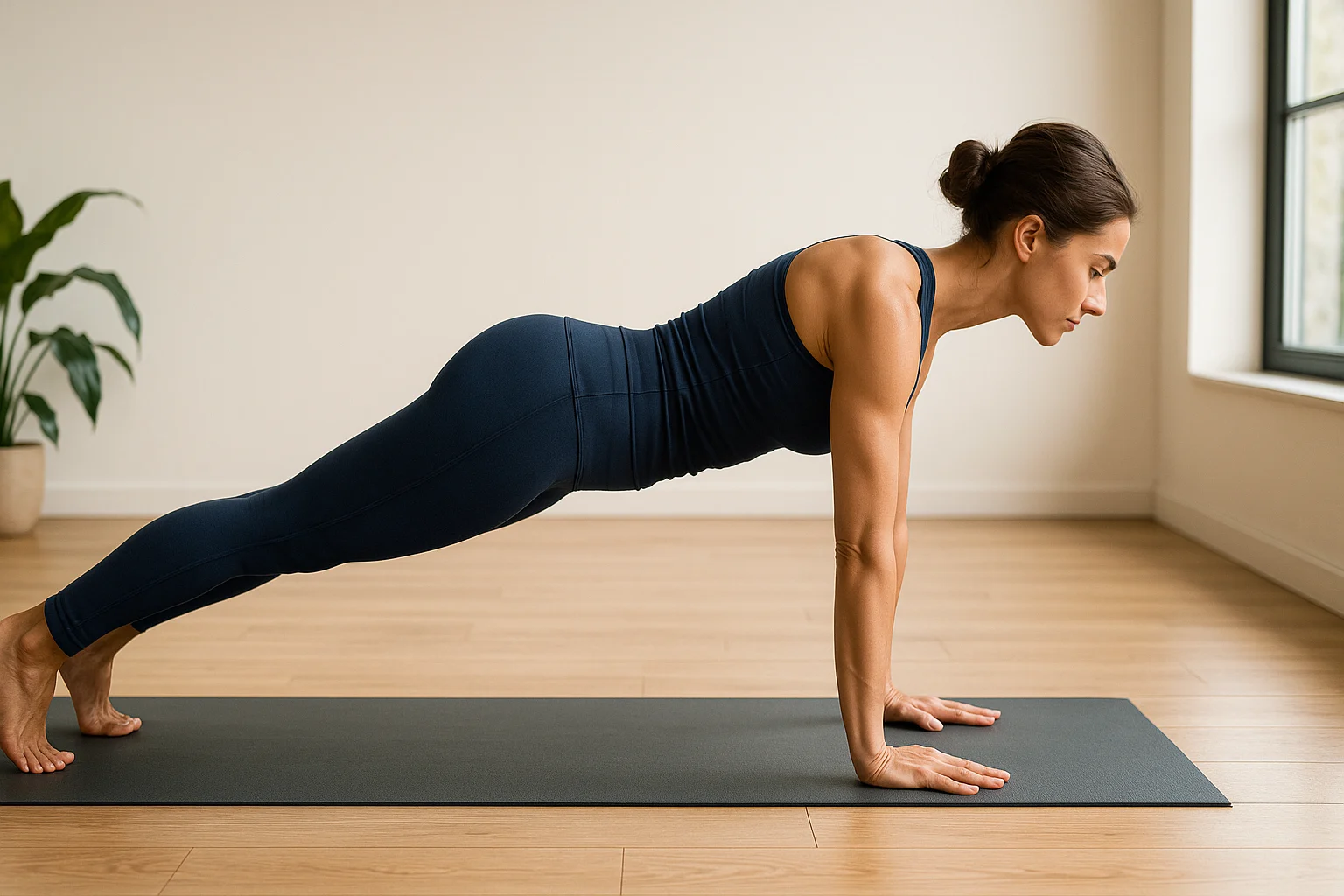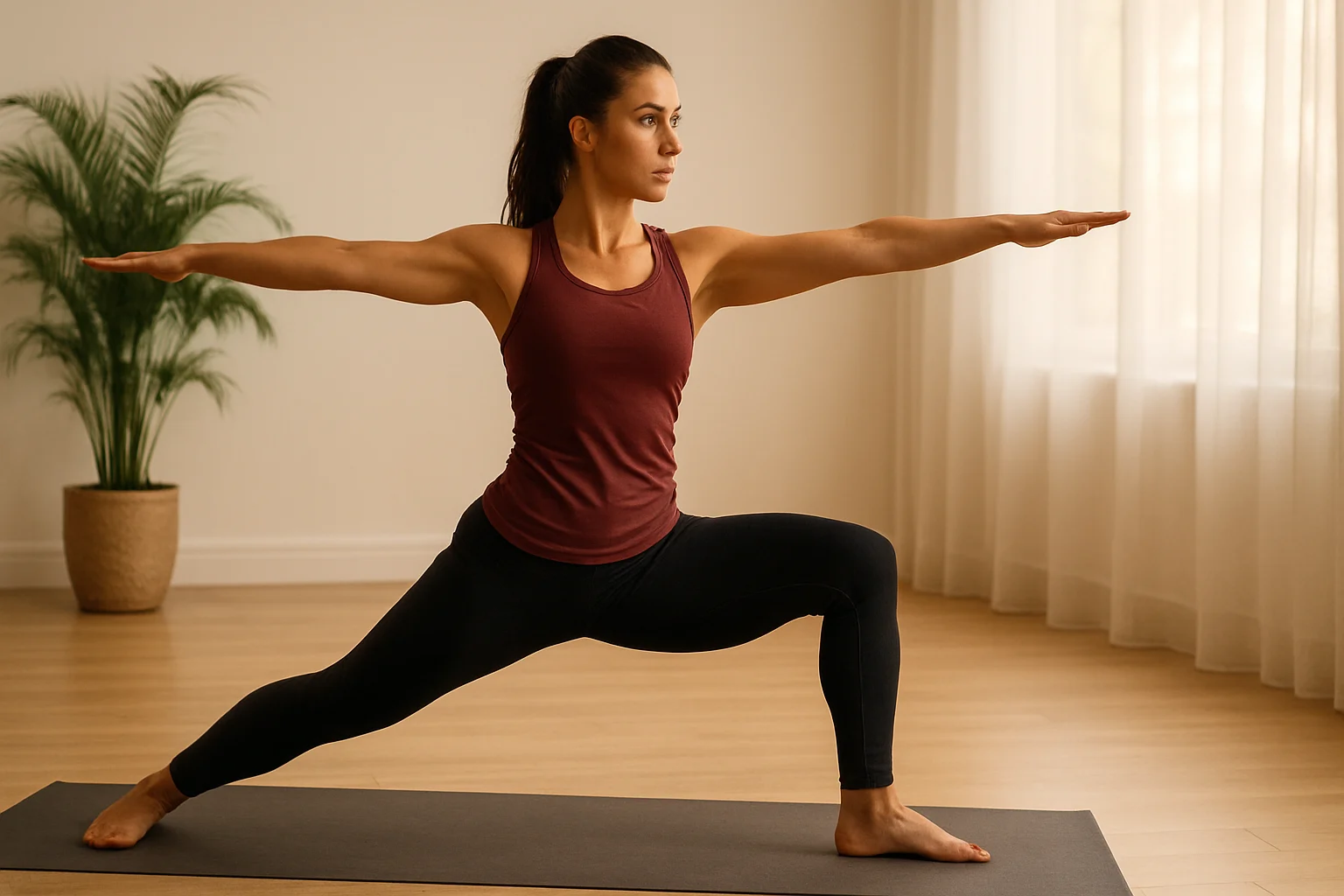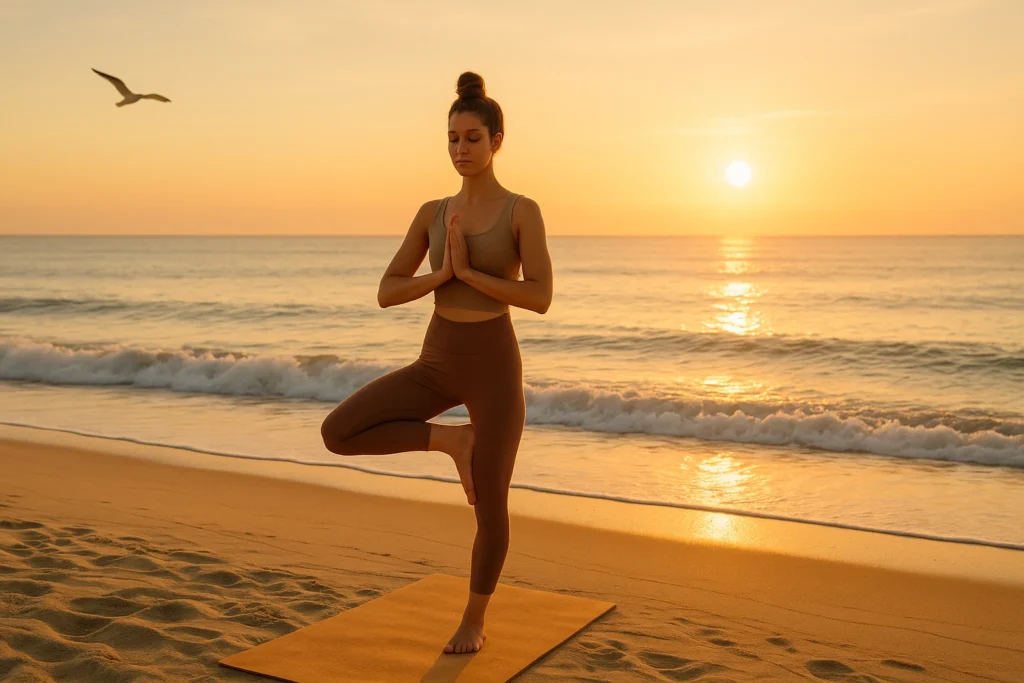
Meet Sarah—a busy mom who carved out 20 minutes a day and soon noticed she could carry groceries and hold Plank a little longer. Strength isn’t only built in the gym; yoga can train it too. If you’re aiming for functional strength, steady endurance, and better balance, you’re in the right spot. Yoga isn’t just stretching—done with intent, it can help you feel sturdier and more at home in your body. Before you start, make sure your basics are set (mat, blocks). For a deeper dive, see our Complete Yoga Flexibility Guide. Ready to power up with a yoga sequence for strength? Let’s dive in!
In this guide, you’ll discover a dynamic yoga sequence to build power, stability, and muscle tone. We’ll cover key poses, alignment tips, modifications for all levels, and how strength yoga poses can help you tone effectively. Roll out your mat and let’s get started!
Choose Your Yoga Sequence
Want to power up your practice? Select a yoga flow below to see how to perform it, its benefits, and counter-stretches.
Select a yoga flow to see the instructions, benefits, and counter-stretches.
Table of Contents
- Key Takeaways for Your Yoga Journey
- Why Choose a Yoga Sequence for Strength?
- Who Benefits from Strength-Focused Yoga?
- Getting Ready for a Power Flow
- How to Create a Yoga Sequence for Strength
- Tips for Getting the Most from Strength Yoga
- 4-Week Progression Plan for Strength
- Frequently Asked Questions
- Conclusion
Key Takeaways for Your Yoga Journey
- Yoga Builds Functional Strength: Discover how a targeted strength-building sequence builds real-world power, endurance, and stability, not just flexibility.
- Master Core Poses: Learn alignment and progression tips for poses like Plank, Chair, Warrior II, Crow, and Bridge.
- Sequence for Impact: Combine poses with breath in a power yoga sequence to maximize strength gains.
- Consistency is Crucial: Regular practice with a strength-building yoga flow develops a strong, resilient body.
This post has affiliate links. We may earn a commission. Learn more.
Why Choose a Yoga Sequence for Strength?
Many assume yoga is only about gentle stretching, but a yoga sequence for strength can actually build functional muscle endurance — the kind you use when carrying groceries, standing tall, or moving with ease throughout your day. Rather than isolating individual muscles like weightlifting does, this approach activates multiple muscle groups simultaneously by using your own body weight. For even greater results, consider combining it with yoga for weight training to support recovery and help prevent injuries. In fact, a randomized controlled trial of older adults reported that eight weeks of Hatha yoga improved measures of strength, flexibility, and balance, with changes comparable to a stretching-strengthening program (view study).
How Yoga Powers Functional Strength
Here’s why yoga lands:
- Muscle endurance: Holding Plank or Chair for steady breaths builds staying power you’ll feel on the last few reps.
- Core stability: Warrior III and other balances light up the deep core that keeps you upright when you sprint for the bus.
- Balance & coordination: Smooth transitions train timing and body awareness—not just single poses.
- Joint support: Building surrounding muscle can help your knees and shoulders feel more supported.
- Mind–body: Your breath becomes a safe “go/no-go” signal so you can challenge yourself without forcing it.
“Yoga isn’t about touching your toes, it’s about what you learn on the way down.” – Jigar Gor
The Science Behind Yoga Strength
Yoga builds strength through:
- Isometrics: Holding Chair builds endurance without moving the joint.
- Bodyweight load: Lifting yourself in Crow asks you to move your own weight—no dumbbells required.
- Compound work: Warrior II recruits legs, hips, core, and shoulders in one go.
Who Benefits from Strength-Focused Yoga?
This strength-focused yoga flow works well for a variety of people:
- Athletes: Boost performance with Warrior III’s balance.
- Seniors: Support mobility with modified Bridge.
- Busy Professionals: Fit 20-minute sessions into hectic schedules.
- Easing back into movement: Try Knee Plank and move mindfully.
Getting Ready for a Power Flow
Before you begin, set up for success:
- Warm-Up: Prepare muscles and joints to avoid injury.
- Listen to Your Body: Modify poses if you feel pain.
- Use Props: Blocks or straps make poses accessible.
- Hydrate: Drink water before and after.
- Clear Space: Ensure room to move freely.
How to Create a Yoga Sequence for Strength
This dynamic power flow targets your core, legs, and upper body — making it a muscle-building yoga routine you can stick with. Move with your breath — inhale to prepare, exhale into effort. Ready to power up?
Sequence Overview for Muscle-Building Yoga
| Pose | Duration | Primary Muscles | Beginner Modification |
|---|---|---|---|
| Plank Pose | 30-60 sec | Core, arms, shoulders | Knees on mat |
| Chair Pose | 5-10 breaths | Quads, glutes, core | Shallow bend |
| Warrior II | 5-10 breaths | Legs, glutes, core | Less deep knee bend |
| Crow Pose | 3-5 breaths | Arms, wrists, core | Toes on block |
| Bridge Pose | 5-10 breaths | Glutes, hamstrings | Block under sacrum |
Warm-Up Flow (5-7 Minutes)
Start gently to awaken your body. Let’s get moving!
- Cat-Cow (Marjaryasana-Bitilasana): On all fours, inhale, drop belly, lift chest and tailbone (Cow). Exhale, round spine, tuck chin (Cat). Repeat 5-8 times. Warms spine and core.
- Thread the Needle: Inhale right arm up, exhale, thread under left armpit, resting on right shoulder and ear. Hold 5 breaths. Repeat other side. Opens shoulders.
- Sun Salutation A (Modified):
- Mountain Pose (Tadasana): Stand tall.
- Inhale: Arms overhead.
- Exhale: Forward Fold (Uttanasana).
- Inhale: Halfway Lift (Ardha Uttanasana).
- Exhale: Step/jump to Plank Pose. Hold a few breaths.
- Exhale: Lower knees, chest, chin (or Chaturanga).
- Inhale: Cobra or Upward-Facing Dog.
- Exhale: Downward-Facing Dog. Hold 5 breaths.
- Inhale: Step/jump to Halfway Lift.
- Exhale: Forward Fold.
- Inhale: Rise to Mountain Pose.
- Repeat 2-3 rounds.
Core Strength Builders (10-12 Minutes)
Your core is your powerhouse. For a focused routine, try our yoga sequence for core strength. Let’s fire it up with Plank!

Plank Pose (Phalakasana) 🧘♀️
- How to: From hands and knees, extend legs back, balancing on balls of feet. Hands under shoulders, fingers spread. Form a straight line from head to heels.
- Alignment Tips: Engage core, keep hips level, shoulders over wrists, gaze forward, press through heels.
- Benefits: Strengthens core, arms, wrists, shoulders, quads. Builds endurance.
- Progression Options: Beginner: Drop knees. Advanced: Hold 30-60 seconds, lift one leg, or try Forearm Plank.
Counter-Stretch: Rest in Child’s Pose to release shoulder tension.
Side Plank (Vasisthasana) ✨
- How to: From Plank, shift weight to right hand and outer right foot. Stack left foot or place in front. Extend left arm up.
- Alignment Tips: Lift hips, stack shoulders, gaze up or forward.
- Benefits: Strengthens obliques, shoulders, wrists, improves balance.
- Progression Options: Beginner: Drop bottom knee. Advanced: Lift top leg or reach arm overhead.
Counter-Stretch: Thread the Needle to open shoulders.
Quad Strength Poses (8-10 Minutes)
Ready to power up your legs? This strength-focused yoga flow includes poses that sculpt quads.

Chair Pose (Utkatasana) 🪑
- How to: From Mountain Pose, inhale arms overhead, exhale, bend knees deeply, sitting back. Keep chest lifted.
- Alignment Tips: Weight in heels, knees behind toes, core engaged, shoulders relaxed.
- Benefits: Strengthens quads, glutes, core, ankles. Builds endurance.
- Progression Options: Beginner: Shallow bend. Advanced: Sink deeper, lift heels, or add twist.
Counter-Stretch: Forward Fold to release hamstrings.
Warrior II (Virabhadrasana II) 🛡️
- How to: Step right foot forward, left foot parallel to back of mat. Bend front knee to 90 degrees, arms out, gaze over front fingertips.
- Alignment Tips: Deep knee bend, engage back leg, open hips, relax shoulders.
- Benefits: Strengthens quads, hamstrings, glutes, core. Opens hips, chest.
- Progression Options: Beginner: Less deep bend. Advanced: Hold longer, transition to Extended Side Angle.
Counter-Stretch: Low Lunge to open hip flexors.
Glute and Balance Poses (7-10 Minutes)
Let’s sculpt glutes and boost balance!
Warrior III (Virabhadrasana III) 🦅
- How to: From standing, shift weight to right foot, hinge forward, lifting left leg back to form a “T.” Arms forward, sides, or back.
- Alignment Tips: Micro-bend standing knee, square hips, engage core, extend spine.
- Benefits: Builds core, leg, back strength. Improves balance.
- Progression Options: Beginner: Hands at heart or use wall. Advanced: Hold longer, add arm variations.
Counter-Stretch: Standing Forward Fold to release lower back.
Upper Body & Arm Balances (8-10 Minutes)
Time to strengthen those arms! Feel the power? These are classic strength yoga poses for your upper body.
Chaturanga Dandasana (Four-Limbed Staff Pose) 💪
- How to: From Plank, shift forward, bend elbows back, hugging ribs, lowering until shoulders align with elbows.
- Alignment Tips: Elbows hug ribs, shoulders no lower than elbows, engage core, gaze forward.
- Benefits: Strengthens upper body, core. Prepares for arm balances.
- Progression Options: Beginner: Drop knees. Advanced: Hold at bottom or lower slowly.
Counter-Stretch: Cobra Pose to open chest.
Crow Pose (Bakasana) 🐦
- How to: From squat, place hands shoulder-width apart, knees high on triceps. Lean forward, lift feet off ground.
- Alignment Tips: Knees on triceps, gaze forward, engage pelvic floor, round upper back.
- Benefits: Builds arm, wrist, core strength. Boosts confidence.
- Progression Options: Beginner: Use cushion, lift one foot. Advanced: Hold longer or straighten arms.
Counter-Stretch: Child’s Pose to rest arms.
Back & Glute Strengtheners (5-7 Minutes)
Don’t neglect your posterior chain. This strength-building flow will also strengthen your back and glutes! For additional back support, try yoga for lower back pain relief.
Bridge Pose (Setu Bandhasana) 🌉
- How to: Lie on back, knees bent, feet hip-width. Press into feet, lift hips. Interlace fingers or keep arms by sides.
- Alignment Tips: Knees over ankles, lift hips, keep neck long, press shoulders down.
- Benefits: Strengthens glutes, hamstrings, lower back. Opens chest.
- Progression Options: Beginner: Block under sacrum. Advanced: Lift one leg.
Counter-Stretch: Knees-to-Chest to release lower back.
Locust Pose (Salabhasana) 🦗
- How to: Lie on belly, arms by sides, palms down. Inhale, lift head, chest, arms, legs.
- Alignment Tips: Engage glutes, back, squeeze shoulder blades, lift from inner thighs.
- Benefits: Strengthens back, glutes, hamstrings. Improves posture.
Counter-Stretch: Child’s Pose to relax spine.
Tips for Getting the Most from Strength Yoga
Looking to make every session count? Here are some simple, effective tips:
- Flow with Breath: Link movements to inhales/exhales for rhythm and focus.
- Hold Poses: Hold challenging poses like Plank for 5–10 breaths to build endurance.
- Balance with Counter-Stretches: Follow strength poses with stretches to maintain flexibility.
- Adjust to Energy: Some days, go lighter. Consistency matters more than perfection.
4-Week Progression Plan for Strength
Build gradually with this plan:
- Week 1: Focus on form. Hold Plank for 20 seconds, Chair for 5 breaths. Use beginner modifications.
- Week 2: Increase hold times (e.g., Plank for 30 seconds). Try one advanced variation (e.g., lift leg in Side Plank).
- Week 3: Hold poses for 8-10 breaths. Add Crow Pose practice with cushion.
- Week 4: Aim for 60-second Plank, full Chaturanga, or lift both feet in Crow.
Frequently Asked Questions
Conclusion
Work through Plank, Chair, Warrior II, Crow, and Bridge, and notice how everyday tasks start to feel easier. Strength isn’t only about heavy weights—it’s about feeling capable in your body. Roll out your mat, try the flow, and check back with yourself in a few weeks to see what changed.


